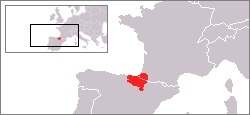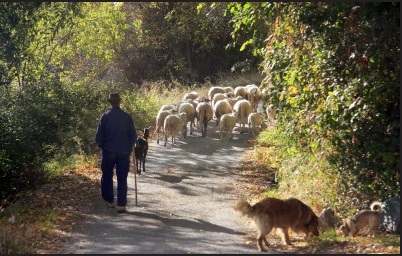

If you travel in certain areas of the American West, you may see signs advertising a Basque restaurant. If you do, stop and treat yourself to one of the best and most unusual restaurant experiences you are ever likely to have.
Basque immigrants came to America from the Basque region of Spain and France, an area stretching from the Bay of Biscay up into the Pyrenees Mountains. In Europe, this ethnic minority is famed for their independent spirit and their extraordinary, flavorful cuisine.


Those who came to America were equally independent, mostly agricultural workers who immigrated in the late 1800s to herd sheep in the American West. They settled in the western rangelands where their flocks could graze freely.


Today their descendents still live largely in or near the places their forefathers settled in the intermountain west, mostly California, Nevada, and Idaho. Their communities are proud of their heritage, and food is central to it.
Traditional Basque food is famed for layering many flavors and textures together, using fresh ingredients and lots of fish in those areas close to the sea. In the western desert of America, those ingredients were unavailable. The Basque adapted their cooking to local foods and cooking styles – using the dutch oven, for instance, and substituting plentiful lamb and potatoes for missing ingredients.
In the boarding houses where seasonally employed sheepherders would spend the winter, Basque women tried to replicate cooking from home, and the custom arose of large, family-style meals around a common table.
Pintos, garbanzos and lentils were a staple; chorizo and homemade sausage complemented traditional specialties: lamb stew, inkfish in sauce, halibut and red bean soup. The food is flavorful, but surprisingly few spices are used. Standbys include garlic, saffron, paprika, parsley, salt, pimento, and a few others, used to simply make good food taste even better.
American Basque cuisine has evolved away from European tradition and become a regional specialty. This food is substantial, less complex, but hearty and rustic. It is typical for the bread to be as fresh-baked and home-made as everything else on the table. The care taken in preparation is evident with each course that comes to the table.
And that is another thing that sets Basque dining apart from most other types of cuisine in America: the dining style itself.
The custom in most Basque restaurants has long been that when the diner walks in for a meal, they are not shown to a single table. They may not even be given a menu. Instead, they’re seated at a long table with others, or may be joined there by newcomers.
Then, item by item, food comes out of the kitchen and is set before the guests. Bread, soup, a bean casserole, the lamb, the fish… it comes in endless parade, whatever the cook has prepared for this evening.
Diners are not only guests; they are treated like members of the extended family. In a “fixed menu,” common-table restaurant, patrons meet other guests, laugh with strangers, and become friends over a meal. To dine in this style is to relive the West where lonely immigrant sheepherders feasted with friends in boarding houses where Basque women cooked Americanized versions of food from home.
Smaller restaurants in small towns are most likely to continue the communal-table tradition. But even if a restaurant has changed to menu-ordering and single tables, the food is still a worthwhile treat. You can find Basque restaurants when traveling the West by looking on Yelp or Citysearch.
View Comments
I love basque food. Actually, i love Basque Country.
Nice post.Basque food looks so delicious.Traditional Basque food is famed for layering many flavors and textures together using fresh ingredients .Basque restaurants are very famous for their the communal-table tradition. Its a great post on Basque food.
Pretty nice post. I just stumbled upon your weblog and wished to say that I've really enjoyed surfing around your blog posts. In any case I’ll be subscribing to your feed and I hope you write again very soon!
Thanks for your kind words, Rosanne. I'll be writing a lot more after the turn of the year and hopefully here at dirjournal.com as well. Thanks for reading!